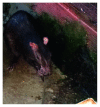Omnivorous Behaviour of the Agouti (Dasyprocta leporina): A Neotropical Rodent with the Potential for Domestication
- PMID: 31192022
- PMCID: PMC6525809
- DOI: 10.1155/2019/3759783
Omnivorous Behaviour of the Agouti (Dasyprocta leporina): A Neotropical Rodent with the Potential for Domestication
Abstract
The agouti is a Neotropical rodent which is mainly utilized for its meat in rural communities. Recently, captive rearing of these animals by wildlife farmers have increased in the Neotropics. This short communication consists of observation of feeding behaviour of captive reared agoutis at the University of the West Indies Field Station in Trinidad and Tobago. This is the first time in Trinidad and Tobago that meat consumption and the omnivorous behaviour of the agouti have been documented in the literature. The consumption of chicken (Gallus domesticus) eggs, dead chickens, and a brown dove (Zenaida macroura) by captive reared agoutis was noted. This document described the omnivorous behaviour of the agouti which is primarily considered a frugivorous animal. Similar studies in South America have shown that wild and captive reared agoutis consumed animal matter. Further work must be done on the dietary needs and nutrient requirements of the agouti at different physiological states.
Figures




Similar articles
-
Dystocia in a Captive Reared Agouti (Dasyprocta leporina) in Trinidad and Tobago, West Indies.Vet Sci. 2020 Mar 4;7(1):30. doi: 10.3390/vetsci7010030. Vet Sci. 2020. PMID: 32143289 Free PMC article.
-
Anthelmintic usage on the Reproductive Parameters in Captive reared Agoutis (Dasyprocta leporina) in Trinidad and Tobago, West Indies.Braz J Biol. 2021 Aug 9;83:e246781. doi: 10.1590/1519-6984.246781. eCollection 2021. Braz J Biol. 2021. PMID: 34378685
-
Mammary Diseases in a Captive Reared Agouti (Dasyprocta leporina) in Trinidad.Vet Sci. 2020 Sep 19;7(3):137. doi: 10.3390/vetsci7030137. Vet Sci. 2020. PMID: 32961654 Free PMC article.
-
Nutrition of Six Selected Neo-Tropical Mammals in Trinidad and Tobago with the Potential for Domestication.Vet Sci. 2018 May 14;5(2):52. doi: 10.3390/vetsci5020052. Vet Sci. 2018. PMID: 29757965 Free PMC article. Review.
-
Natural Habitat, Housing, and Restraint of Six Selected Neotropical Animals in Trinidad and Tobago with the Potential for Domestication.Scientifica (Cairo). 2020 Mar 26;2020:9741762. doi: 10.1155/2020/9741762. eCollection 2020. Scientifica (Cairo). 2020. PMID: 32300488 Free PMC article. Review.
Cited by
-
Neo-tropical species production: a sustainable strategy for climate change adaptation in neo-tropical regions.BMC Vet Res. 2025 Mar 3;21(1):134. doi: 10.1186/s12917-025-04558-6. BMC Vet Res. 2025. PMID: 40025469 Free PMC article. Review.
-
Trichuris spp. in Animals, with Specific Reference to Neo-Tropical Rodents.Vet Sci. 2021 Jan 21;8(2):15. doi: 10.3390/vetsci8020015. Vet Sci. 2021. PMID: 33494133 Free PMC article. Review.
-
Cryopreservation of Testicular Tissue from Adult Red-Rumped Agoutis (Dasyprocta leporina Linnaeus, 1758).Animals (Basel). 2022 Mar 16;12(6):738. doi: 10.3390/ani12060738. Animals (Basel). 2022. PMID: 35327135 Free PMC article.
-
Dystocia in a Captive Reared Agouti (Dasyprocta leporina) in Trinidad and Tobago, West Indies.Vet Sci. 2020 Mar 4;7(1):30. doi: 10.3390/vetsci7010030. Vet Sci. 2020. PMID: 32143289 Free PMC article.
-
Endoparasites of Selected Native Non-Domesticated Mammals in the Neotropics (New World Tropics).Vet Sci. 2019 Oct 30;6(4):87. doi: 10.3390/vetsci6040087. Vet Sci. 2019. PMID: 31671585 Free PMC article. Review.
References
-
- Brown-Uddenberg R. C., Garcia G. W., Baptiste Q. S., Counand T., Adogwa A. O., Sampson T. The Agouti (Dasyprocta leporina, D. aguti) Booklet and Producers’ Manual. Champs Fleurs, Trinidad and Tobago: GWG Publications; 2014. http://ostasp.brinkster.net/
-
- Hardouin J., Thys E., Joiris V., Fielding D. Mini-livestock breeding with indigenous species in the tropics. Livestock Research for Rural Development. 2003;15(4)
-
- Silvius K. M., Fragoso J. M. V. Red-rumped agouti (Dasyprocta leporina) home range use in an Amazonian forest: implications for the aggregated distribution of forest trees. Biotropica. 2003;35(1):74–83. doi: 10.1111/j.1744-7429.2003.tb00264.x. - DOI
-
- Garcia G. W., Baptiste Q. S., Adogwa A. O., Kakuni M., Arishima K., Makita T. The digestive system of the agouti (Dasyprocta leporina)-gross anatomy and histology. Japanese Journal of Zoo and Wildlife Medicine. 2000;5(1):55–66. doi: 10.5686/jjzwm.5.55. - DOI
LinkOut - more resources
Full Text Sources

